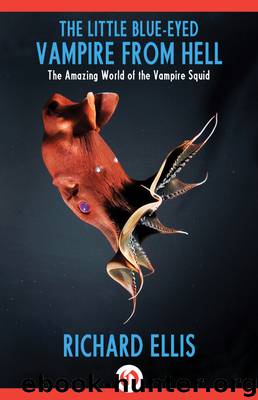Little Blue-Eyed Vampire from Hell by Richard Ellis

Author:Richard Ellis [Ellis, Richard]
Language: eng
Format: epub
ISBN: 978-1-4532-6487-4
Publisher: Open Road Media
The Caribbean reef squid, Sepioteuthis sepioidea, switches on the iridescence.
Photograph © John Muhilly / SeaPics.com
In their 1983 study of chromatic components in cephalopods, Cloney and Brocco wrote that “in various combinations, these components produce colors and participate in physiological changes,” implying that a species can incorporate any or all of these elements into its body palette to produce differing or changing looks. “We know of no other organisms,” wrote researcher Izumi and his team in 2010, “in which the iridescent structures themselves are assembled and disassembled under fast control rather than slightly modulated or shuttered.” Iridophores, like chromatophores and photophores, are under the animal’s control, and can be activated at will. Cephalopods, then, are the only animals that can adjust their iridescence to suit their circumstances. While some species, such as the bobtail squid Euprymna, have “static iridescence” (not under the animal’s control), the dynamically changeable appearance of the squid genus Loligo, the iridescence of the Caribbean reef squid, and the flashing rings in the blue-ringed octopus are functions of intentionally modified iridocytes.
The vampire squid’s skin is brown because it has black chromatophores interspersed with reddish-brown ones, but the muscles that enable rapid color change have been lost, and it is probably unable to change color. Most squid can expand or contract their chromatophores at will, altering their color scheme or pattern arrangement, but the reigning champions of color-change are the cuttlefish, which (along with some species of reef squid), can not only change color in split seconds, but can make waves or stripes of contrasting colors flow across their bodies. From the cephalopod toolbox, Vampyroteuthis does not make use of color-changing chromatophores or dynamic iridescence, but it compensates by emphasizing the photophore component. Its complex system of light organs—giant photophores, luminous arm tips, and a glowing cloud that can be emitted—seem to serve the animal very well indeed.
The computer scientist, musician, and virtual-reality pioneer Jaron Lanier is a big fan of cephalopods. In his 2010 book You Are Not a Gadget, he said, “As far as I’m concerned, cephalopods are the strangest smart animals on earth. They offer the best standing example of how truly different intelligent extraterrestrials (if they exist) might be from us with clues about potential futures for our own species…The raw brainpower of cephalopods seems to have more potential than the mammalian brain. Cephalopods can do all sorts of things, like think in 3-D and morph, which would be fabulous innate skills in a high-tech future.” (Sometime after the 1991 publication of The Search for the Giant Squid, in which I discussed the chromatophores of squid and octopuses, Jaron Lanier paid me a visit to inquire about cephalopods’ astonishing ability to change color. He wanted to know if this talent could somehow be transferred to humans, so they could make tattoos appear and disappear at will.)
Aboard the Valdivia expedition in 1899, Carl Chun observed some individuals of the small squid Lycoteuthis diadema in a container on deck:
Among the marvels of coloration which the animals of the deep sea exhibited to us nothing can be even distantly compared with the hues of these organs.
Download
This site does not store any files on its server. We only index and link to content provided by other sites. Please contact the content providers to delete copyright contents if any and email us, we'll remove relevant links or contents immediately.
The Lonely City by Olivia Laing(4750)
Animal Frequency by Melissa Alvarez(4395)
All Creatures Great and Small by James Herriot(4233)
Walking by Henry David Thoreau(3894)
Exit West by Mohsin Hamid(3778)
Origin Story: A Big History of Everything by David Christian(3649)
COSMOS by Carl Sagan(3554)
How to Read Water: Clues and Patterns from Puddles to the Sea (Natural Navigation) by Tristan Gooley(3409)
Hedgerow by John Wright(3277)
The Inner Life of Animals by Peter Wohlleben(3259)
How to Read Nature by Tristan Gooley(3249)
How to Do Nothing by Jenny Odell(3232)
Project Animal Farm: An Accidental Journey into the Secret World of Farming and the Truth About Our Food by Sonia Faruqi(3178)
Origin Story by David Christian(3148)
Water by Ian Miller(3128)
A Forest Journey by John Perlin(3027)
The Plant Messiah by Carlos Magdalena(2883)
A Wilder Time by William E. Glassley(2818)
Forests: A Very Short Introduction by Jaboury Ghazoul(2790)
